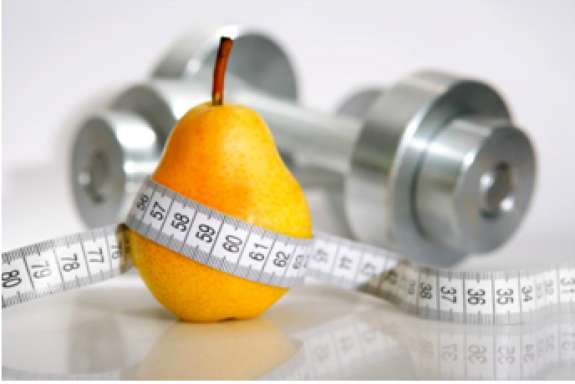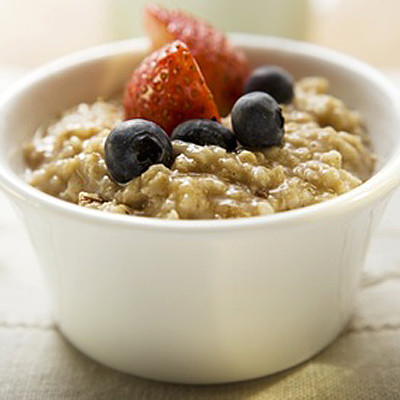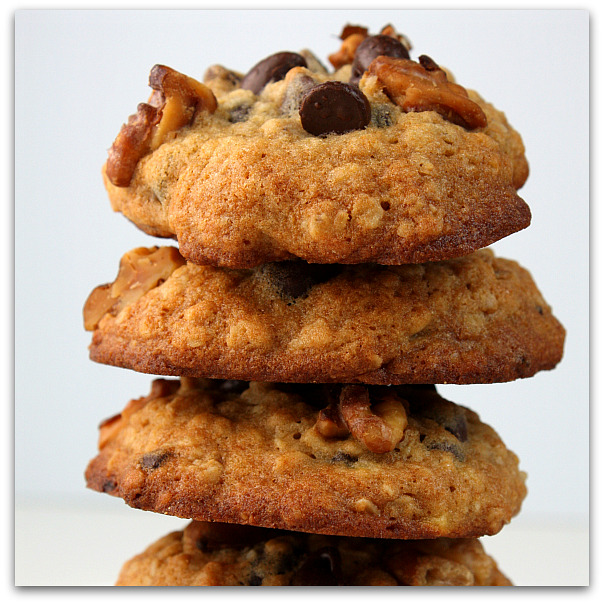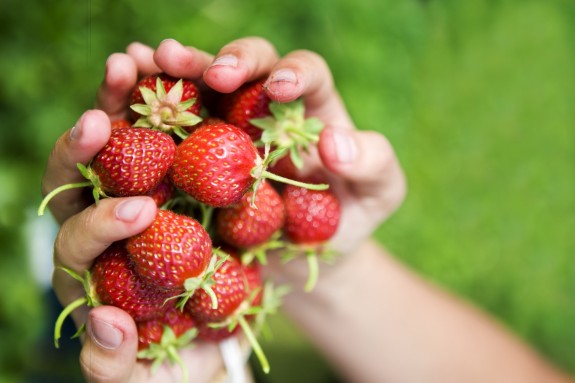A Lethal, Cancer-Causing Bacteria Killed by Yogurt and Kefir
- At August 07, 2016
- By Katherine
- In Articles, News
 0
0
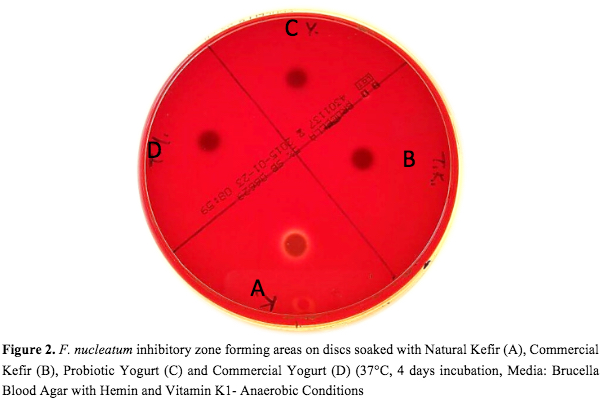
Inhibition of F. nucleatum by natural kefir, probiotic yogurt, commercial yogurt and commercial kefir samples
You’ve all heard about the health benefits of the probiotic bacteria found in yogurt and other similar fermented dairy products such as kefir. This recently published study provides more evidence of yogurt cultures’ actions against serious disease-causing pathogens, such as Fusobacterium nucleatum.
F. nucleatum can cause diseases in the mouth, teeth, brain, pleura, lungs and liver. It induces fetal death in pregnant women and can lead to colon cancer by binding to the lining of the gastrointestinal tract, according to a recent study in the journal, Functional Foods in Health and Disease.
In this study, when yogurt and kefir were added to a petri dish filled with F. nucleatum and incubated for 3 days, there appeared clear zones where the yogurt and kefir were placed. Thus showing inhibition of the growth of F. nucleatum. Interestingly, the plain milk used for the yogurt and kefir did not show an inhibitory effect, but the higher the concentration of the kefir and yogurt probiotic bacteria, the more F. nucleatum’s growth was inhibited.
“Previous studies have indicated that fermented dairy products can cause probiotic effects such as improvement in digestive system health, serum cholesterol reduction, and improvement in lactose tolerance, improved immune function, control of irritable bowel symptoms, as well as anticarcinogenic properties. Kefir is known to have positive effects on health and especially intestinal health. Therefore, these findings are important for showing an inhibition effect of fermented dairy products against a pathogen and possible carcinogen. These results suggest that regular consumption of natural fermented dairy products especially kefirshould be included in a functional diet. The impact of these cultured dairy products could be promising and warrants further investigation with in vivo studies,” according to the authors of the study.
Fresh Kale and Summer Peach Salad with Toasted Almonds and Balsamic Vinaigrette
- At July 31, 2016
- By Katherine
- In News, Recipes
 1
1
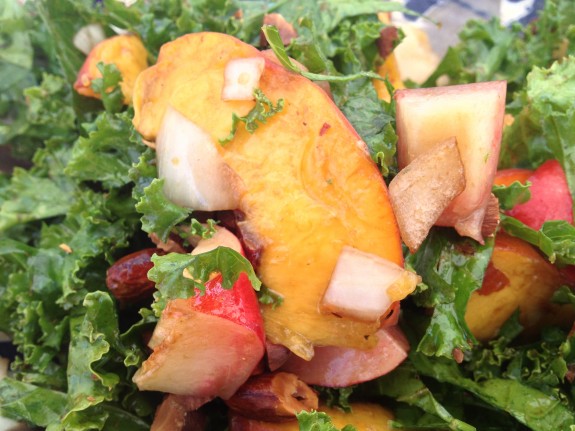 The local peaches at this year’s farmers’ markets are exceptional: sweet, juicy, flavorful. This recipe is a perfect way to feature them at any gathering. And it’s always a favorite! Excerpted from my book: Diet Simple Farm to Table Recipes: 50 New Reasons to Cook in Season!
The local peaches at this year’s farmers’ markets are exceptional: sweet, juicy, flavorful. This recipe is a perfect way to feature them at any gathering. And it’s always a favorite! Excerpted from my book: Diet Simple Farm to Table Recipes: 50 New Reasons to Cook in Season!
Serves 6
Vinaigrette:
3 Tablespoons Extra Virgin Olive Oil
1 Tablespoon Balsamic Vinegar
Salt and Pepper to taste
Salad Ingredients:
6 Handfuls of fresh Kale (or other greens), washed, tough stems removed, and torn into bite-sized pieces
2 Cups Fresh Sliced Summer Peaches and/or any seasonal Berries
2 Ounces toasted slivered Almonds
½ Sweet Onion, peeled and sliced
In a large bowl, add the olive oil, vinegar, salt and pepper. Whisk together. Add the kale, onion, almonds, and peaches and toss together. Serve immediately.
Katherine’s Diet Tip #2: Download Your Calories!
- At June 06, 2016
- By Katherine
- In Articles, News
 0
0
What’s one of the most effective, enjoyable, and simple changes – for weight loss and health – you can make in your eating? Simple: Add breakfast to your day. Katherine explains to Washingtonian Magazine…
Also, CNN spoke with Katherine about breakfast. Here’s a part of that conversation.
What exactly is it about breakfast that makes it so beneficial? And are all are breakfasts created equal? A study from Pediatrics looked at 2,000 teenagers and found that teens who ate breakfast weighed less, exercised more and ate healthier food than their classmates who didn’t eat breakfast. More studies have confirmed this link with breakfast and adults, too.
CNN: Explain the real benefits of eating breakfast. In your experience, have you seen among your patients the same results this study showed: that people who aren’t eating breakfast actually weigh more? How is that?
Tallmadge: In one study, people who ate more in the beginning [of] the day ate fewer overall. As soon as you start eating, you start raising your metabolism; your whole body is burning calories earlier in the day. Helps control your appetite. People who skip breakfast — victims of vending machines. The pickers — they eat overall more calories, tend to eat more. In another study, people who ate larger breakfasts and lunches, with lighter dinners, were more likely to manage their weight.
CNN: What about for the people who say, “I just don’t have time to eat breakfast”? What are your tips?
Tallmadge: I know we’re all busy, but everyone has to make time to eat breakfast. In Diet Simple I have tons of ways people can fit breakfast into a busy day!
Scientific studies confirm breakfast eaters get more nutrients for the whole day, are more likely to lose and maintain healthy weights, have more energy, concentrate better, and eat fewer overall calories during the day.
I have great ideas for easy and delicious breakfasts in Diet Simple. My favorite breakfast? a warm bowl of oatmeal cooked in milk with fruit and nuts… even a peanut butter sandwich with yogurt and fruit, or eggs on whole grain toast with spicy chicken sausage… Do you like lox on a whole grain bagel? How about whole grain blueberry pecan pancakes? All excellent choices… Bon Appetit!
Katherine’s Diet Tip #1: Minesweep for Calorie Bombs!
- At May 31, 2016
- By Katherine
- In Articles, News
 0
0
Are you ready for summer? I mean, is your body ready … to shed the heavy coats and sweaters, to wear lighter weight, more form-fitting clothes? If not, or if you would just like to learn some good tips, follow me here every Monday with proven strategies to lose weight, improve your health or just increase your knowledge about nutrition. Through early summer, we’ll be losing weight together, so you’ll be ready for the warmer days to come!
Losing weight is not about discipline or will power. It’s about controlling your environment. Period.
We all have different strengths and weaknesses which must be considered when cutting calories or making any other healthful lifestyle changes. Let’s talk about me, Katherine Tallmadge. One of my main weaknesses is chocolate. I can’t stop with one piece. That’s simply not “normal” for me. I’ll occansionally indulge my passion with a small piece of dark chocolate, but I’ve learned never to bring home a full box of chocolate-covered caramels. It will be gone in a day or two, max.
I’m no better with chips. I have no self-control, and I know it. So I’ll occasionally buy a 1-ounce bag. But a big bag? Never!
One of my strengths (finally, something positive!) is that I love fruit. I stock up on cut-up fruit so I always have it at my fingertips.
You have to recognize your own “mines.” I advise everyone to minesweep the kitchen for those calorie bombs that can explode your weight. Have a hard time resisting ice cream? Then get rid of the half gallon. Candy bar pitfall? Toss out the leftovers from the Easter season.
Minesweeping your kitchen periodically to get rid of things you shouldn’t have in the house in the first place will save a tremendous amount of calories over time. Add the things that you like and should be eating, and you’ll do even better! Be good to yourself and make your negative behaviors hard and your good behaviors easy.
If just one candy bar is replaced by an apple every day, you’ll save 175 calories. That adds up to about 18 pounds lost in one year!
* Excerpted from “Diet Simple: 195 Mental Tricks, Substitutions, Habits & Inspirations” (LifeLine Press) by Katherine Tallmadge
Prenatal Fruit Intake Boosts Cognition in Infants + Springtime Strawberry Salad
Some of the most interesting nutrition studies I’ve read have to do with the prenatal diet and subsequent effects in children. The subject is vast and the outcomes amazing. Did you know that when pregnant moms drink high amounts of carrot juice during pregnancy, their toddlers are more likely to choose carrots over other vegetables? Or, that the more varied a pregnant mom’s diet, the more her child will choose and enjoy a wider variety of foods? All proven by science!
So it’s no surprise that a new study published in The Lancet found that prenatal fruit consumption is correlated with superior cognition in the mothers’ one-year-old infants – though there was no effect if fruit was only fed to the child during the year after birth. So, what may explain this finding?
Evolution may explain, in part, this advantage of fruit-eating. During the neolithic (stone age) period about 12,000 years ago and for thousands of years thereafter, we subsisted mainly on fruits and vegetables; which comprised about 65% of our calories, according to S. Boyd Eaton, from the department of Anthropology at Emory University in an interview and in his essay, “Evolution, Diet and Health.” That may mean that brain development is still dependent on the same high level of vitamins, minerals, antioxidants, and other positive nutrients that kind of diet would provide. And this could help explain why, even today, a high fruit diet is correlated with so many positive health benefits: reduced incidence of diabetes, heart disease, cancer, arthritis, eye disease, and other conditions. Keep in mind, too, that the health-giving Mediterranean Diet had 12 to 13 servings of fruits and vegetables daily, and it’s known as one of the healthiest diets on the planet.
Fruit is so easy to eat every day, and the local fruit season is just beginning to get exciting. I was most fortunate to receive one of the most delicious dishes I’ve ever eaten this weekend when my friend and neighbor, Mike Gardner, brought me his salad:
Only Certain Fruits & Vegetables May Cause Weight Loss
- At March 01, 2016
- By Katherine
- In Articles, News
 3
3
For the first time, scientists have discovered certain fruits and vegetables – and not others – are associated with preventing weight gain over the course of many years regardless of calories, according to a recent Harvard study published in the British Medical Journal. These fruits and vegetables contain a class of phytonutrients called flavonoids, a plant compound with anti-inflammatory and anti-oxidant properties, among other benefits.
“The particular fruits and vegetables associated with less weight gain are rich sources of several flavonoid subclasses, particularly flavonols, anthocyanins, and flavones. Animal models and short term human studies provide evidence for underlying mechanisms that relate flavonoids to weight: several flavonoid subclasses have been shown to decrease calorie intake, increase blood sugar uptake in muscle in humans, and decrease blood sugar uptake in fat tissue in test tube studies. Other studies, predominantly focusing on green tea, a rich source of the flavan-3-ol subclass of flavonoids, provide evidence to suggest that flavonoids may decrease fat absorption, increase energy expenditure, and inhibit body fat synthesis,” according to the study.
In the study, anthocyaninins, the blue pigment in many fruits and vegetables, were mainly found in blueberries and strawberries, among others. Flavan-3-ols were mainly from tea, apples, pears, and peppers.
So, while it’s important for your health and weight management to eat at least 5 cups of fruits and vegetables daily, you may want to consider adding these very specific fruits and vegetables to your routine. “An Apple A Day…”
Kale! Kale! Everywhere!
Kale and Spinach Gratin with Garlic, Rosemary, and Thyme
(excerpted from Diet Simple Farm to Table Recipes)
Serves 6
1 pound Kale, cleaned and stems removed
2 pounds Spinach, cleaned and stems removed
1 Tablespoon Olive or Canola Oil
1 Large Garlic Clove, minced
2 teaspoons fresh Rosemary, chopped (or 1 tsp dry)
1 teaspoon fresh Thyme leaves, chopped (or ½ tsp dry)
1 recipe Olive Oil Bechamel Sauce (see recipe)
Salt and Freshly Ground Pepper to taste
¼ Cup Parmesan or Gruyere Cheese, freshly grated
Preheat oven to 400 degrees F. Wash the Kale and Spinach and remove the tough stems. Chop roughly. Heat the oil in a large iron skillet over medium-low heat. Add the garlic and cook until it just begins to color. Add the greens, the rosemary, and thyme to the pan, and let cook a couple of more minutes while stirring until the greens are wilted.
Stir the Bechamel sauce into the greens. Add salt and pepper. Pour into an oiled 2-quart soufflé or heat resistant glass dish and sprinkle the cheese on top. Bake at 400 degrees F for 20 to 30 minutes, or until the top is just beginning to brown.
Olive Oil Bechamel Sauce
This is a classic French white sauce, but using healthy olive oil instead of butter.
Makes 2.5 cups
3 Cups 1% Milk
2 Tablespoons Olive Oil
2 Tablespoons Flour
Salt and Ground Pepper to taste
Pinch of grated nutmeg (optional)
Simmer the milk in a saucepan on medium-low heat. Meanwhile, heat the olive oil in a heavy skillet. Add a bit of flour, and when it sizzles, add the rest. Stir constantly with a wooden spoon or whisk over medium heat. Do not brown. Whisk in the hot milk. Return the mixture to the heat, stirring until the sauce thickens. Reduce to low making sure it does not burn. Add salt, pepper and nutmeg to taste.
Deep Green Leafy Vegetables have the highest antioxidant content of all vegetables. High in fiber, they are rich in minerals, B-vitamins, beta-carotene, and lutein, a compound which may help reduce the risk of age-related macular degeneration (the leading cause of preventable blindness) and other eye diseases such as cataracts. Absorption of carotenoids, such as lutein, in your body is increased by cooking and by the presence of fat (so cook in a little healthy olive or canola oil!).
Supplement Manufacturers Sued and Arrested for False Claims
- At December 27, 2015
- By Katherine
- In Articles, News
 0
0

The United States Department of Justice brings criminal charges against popular supplement manufacturers
There are a LOT of dietary supplements on the market. They all make lots of claims about what they can do for your body and health – many in particular tend to trumpet their ingredients, especially if they’re “all natural.”
Well, the Department of Justice thinks we can’t trust what the supplements tell us. DOJ brought civil and criminal actions against 117 – yes, you read that correctly, 117 – individuals and entities. Of those, 89 have so far been the subject of cases.
Some are accused of mislabeling because the product has ingredients not listed on the label. Others are charged with making claims about what the supplement can do without adequate supporting scientific evidence. An Assistant Attorney with DOJ said they brought these actions “so consumers know the serious health risks of untested products.”
One particularly bad case is USPlabs LLC, which made both workout and weight loss supplements. DOJ alleges that USPlabs used synthetic stimulants instead of natural plant extracts that they advertised. Further, USPlabs is charged with knowing that one supplement, OxyElite Pro, might cause liver toxicity and secretly selling OxyElite despite telling the FDA it would stop. Because of this, 6 employees have been arrested, and company assets have been seized.
You can read more information about UPSlabs and other companies in their press release. But use this as a warning, and be careful what supplements you buy! You should always do your research on supplements before you add them to your routine – talk to a health professional if you can! At the very least, though, be glad that someone is working toward your best interest.
New Studies on Cocoa: Reduces Wrinkles and Protects Against Alzheimer’s Disease
- At November 29, 2015
- By Katherine
- In Articles, News
 0
0
For most people, chocolate is a delicious treat to enjoy in moderation. Some new scientific work, though, may give you an excuse to treat yourself more often.
The first, a study published in the Journal of Nutrition, examined the effects of cocoa on the moderately sun damaged skin of women aged 43 to 86. The participants drank flavanol-enhanced cocoa drinks, containing 320 mg flavanols** daily, over 24 weeks. It’s been established in previous studies that flavanols in cocoa – and other foods – help maintain a healthy vascular system, relax blood vessels (lowering blood pressure), reduce blood clotting – an aspirin-like affect –reduce oxidative damage, and improve blood flow. This new study found that women who drank the flavanol – fortified cocoa drink (containing the equivalent of about 4 tablespoons of cocoa daily**) experienced reduced wrinkles and increased skin elasticity, thereby reducing the effects of sun damage and aging – probably due mostly to their antioxidant and anti-inflammatory properties.
Cocoa flavanols may impact brain aging, too, according to a recent Journal of Alzheimer’s Disease review. Previous research has shown that flavanols contribute to healthy brain aging and cognitive decline prevention by improving blood flow to the brain and reducing the oxidative and inflammatory damage which occurs with aging. But cocoa harvesting and production produces highly variable levels of flavanols in cocoa products. So scientists are looking for more consistent methods for developing cocoa flavanol formulas containing higher levels of flavanols. “The ultimate goal of this review is to provide recommendations for future developments of cocoa extracts as a therapeutic agent in AD [Alzheimer’s Disease].”
These results could mean big things down the line for brain and skin health! Meanwhile, keep in mind that flavanols are also found in tea, wine and many fruits and vegetables. Also, nutrition studies tend to use concentrated forms of nutrients so the effects are more measurable and significant. Conclusion: eat a plant-based diet!
Read more extensive information on cocoa and its health benefits…
Katherine’s Chocolate for Health Tips:
If you’re eating chocolate for health benefits, you’ll need to be very discriminating in your selections.
You’ll get more flavanols, and therefore health benefits, with less processing. The first choice is cocoa, which isn’t Dutch processed – as when cocoa is “Dutch processed with alkali” the flavanols are reduced. Look for chocolate which has the highest percentage of cocoa as possible and to save calories, look for chocolate with lower fat and sugar levels. In general, cocoa is your best first choice. Second choice is a semisweet or bittersweet chocolate with a high cocoa percentage. Some chocolates go as high as 85% cocoa, but legally can be as low as 35%. I recommend no more than an ounce a day, which may be about 110 – 150 calories, depending on the chocolate. Any more than that and you’re probably going to take in too many calories for weight control
**The numbers:
Type of Chocolate Mg Flavonols Calories
1.3 oz Dark Chocolate Bars, Average*: 82 mg 187
1.3 oz Milk Chocolate Bars, Average*: 42 mg 198
1 TBSP Unsweetened Cocoa Powder, Average*: 75 mg 12
*USDA’s Nutrient Data Laboratory

